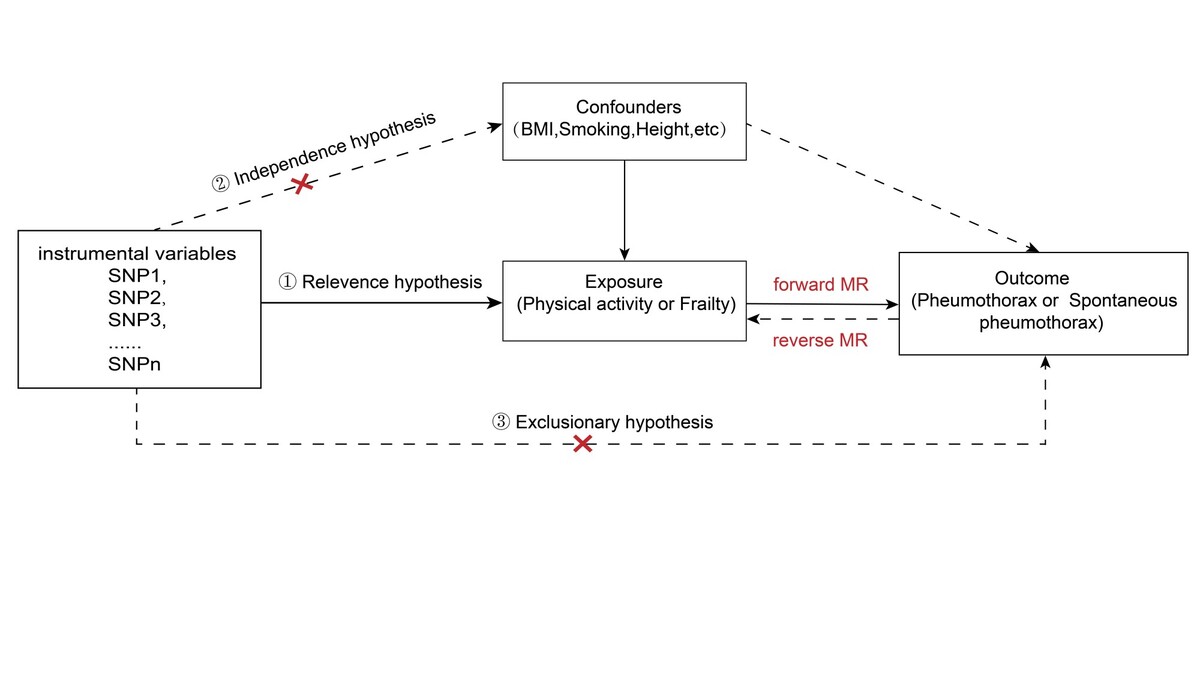Current issue
Archive
Manuscripts accepted
About the Journal
Editorial office
Editorial board
Section Editors
Abstracting and indexing
Subscription
Contact
Ethical standards and procedures
Most read articles
Instructions for authors
Article Processing Charge (APC)
Regulations of paying article processing charge (APC)
THORACIC SURGERY / RESEARCH PAPER
Causal relationship between physical activity, frailty and pneumothorax: univariable, bidirectional and multivariable Mendelian randomization study
1
Jinhua Municipal Central Hospital, Affiliated Jinhua Hospital, Zhejiang University School of Medicine, China
2
Jinhua Municipal Central Hospital, China
Submission date: 2025-05-24
Final revision date: 2025-07-16
Acceptance date: 2025-08-03
Online publication date: 2025-10-26
KEYWORDS
TOPICS
ABSTRACT
Introduction:
Patients with pneumothorax frequently experience respiratory distress. High-intensity physical exertion and varying degrees of weakness can exacerbate respiratory difficulties, potentially precipitating pneumothorax. The aim of this study was to investigate the causal relationship between physical activity and frailty and pneumothorax using Two-Sample Mendelian randomization (TSMR).
Material and methods:
Using Mendelian randomization (MR) analyses, we examined the potential causal relationship between physical activity, frailty and the risk of pneumothorax. The study was analysed using five different methods, mainly using inverse variance weighted (IVW) to draw causal inferences. In addition, sensitivity analyses were used to assess potential horizontal pleiotropy and heterogeneity in the results, indicating the robustness of the results.
Results:
Our analyses found that light DIY reduced the risk of pneumothorax, but did not find a causal association between other levels of physical activity and pneumothorax. In addition, frailty index (FI) showed a positive association with the risk of developing spontaneous pneumothorax, and this causal relationship persisted after adjustment for body mass index (BMI) and light DIY. Sensitivity analyses further validate the robustness of our findings.
Conclusions:
Our findings support the ability of light DIY to reduce the risk of pneumothorax development. It also emphasises the need for frail individuals to be more aware of the need to protect against pneumothorax in their daily lives. We encourage appropriate exercise to improve fitness and reduce the risk of pneumothorax.
Patients with pneumothorax frequently experience respiratory distress. High-intensity physical exertion and varying degrees of weakness can exacerbate respiratory difficulties, potentially precipitating pneumothorax. The aim of this study was to investigate the causal relationship between physical activity and frailty and pneumothorax using Two-Sample Mendelian randomization (TSMR).
Material and methods:
Using Mendelian randomization (MR) analyses, we examined the potential causal relationship between physical activity, frailty and the risk of pneumothorax. The study was analysed using five different methods, mainly using inverse variance weighted (IVW) to draw causal inferences. In addition, sensitivity analyses were used to assess potential horizontal pleiotropy and heterogeneity in the results, indicating the robustness of the results.
Results:
Our analyses found that light DIY reduced the risk of pneumothorax, but did not find a causal association between other levels of physical activity and pneumothorax. In addition, frailty index (FI) showed a positive association with the risk of developing spontaneous pneumothorax, and this causal relationship persisted after adjustment for body mass index (BMI) and light DIY. Sensitivity analyses further validate the robustness of our findings.
Conclusions:
Our findings support the ability of light DIY to reduce the risk of pneumothorax development. It also emphasises the need for frail individuals to be more aware of the need to protect against pneumothorax in their daily lives. We encourage appropriate exercise to improve fitness and reduce the risk of pneumothorax.
Share
RELATED ARTICLE
We process personal data collected when visiting the website. The function of obtaining information about users and their behavior is carried out by voluntarily entered information in forms and saving cookies in end devices. Data, including cookies, are used to provide services, improve the user experience and to analyze the traffic in accordance with the Privacy policy. Data are also collected and processed by Google Analytics tool (more).
You can change cookies settings in your browser. Restricted use of cookies in the browser configuration may affect some functionalities of the website.
You can change cookies settings in your browser. Restricted use of cookies in the browser configuration may affect some functionalities of the website.



